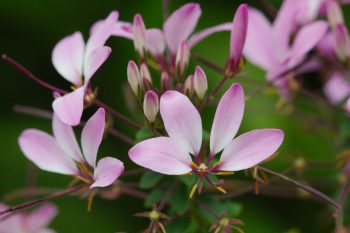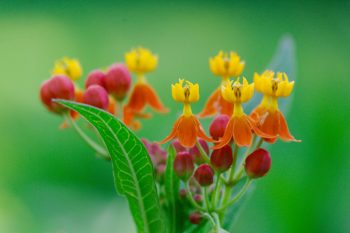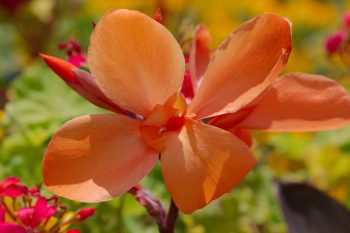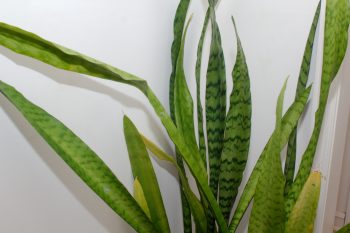Commonly known as spider flower Cleome is a fast-growing, tender perennial grown here as an annual (it’s only hardy in USDA zones 9 and 10). This variety, ‘Señorita Rosalita’, is “noted for having no thorns, no unpleasant aroma, no sticky foliage, no seedpods and better disease resistance” (Missouri Botanical Garden Plant Finder). We love it and it’s been a regular feature in a container on out back patio. We really should plant more of them, as they always perform very well and bloom basically all summer from mid-June well into October or November.
Tagged With: Tender Perennial
Cleome ‘Señorita Rosalita’
Asclepias curassavica Orange
This butterfly weed, Asclepias curassavica, is also known as blood flower. Cathy recently bought a few plants in both orange (this one) and all yellow. Sadly, it is not hardy enough for in-ground planting as a perennial here, but it should do well in containers and brighten up the back patio. This one is in a container right outside our kitchen door and looks great against the green backdrop of Rudbekia growing around the patio. I especially like the bi-color nature of this one, although the all-yellow variety is nice, too.
Bird of Paradise Flower
Cathy, Margaret, and I went to Brookside Gardens this afternoon. It was such a wonderfully beautiful day we were not surprised by the number of people there. Nevertheless, we were able to find a parking spot and wonder around the garden for a while. We often go there in the spring, when early flowers are in bloom. I would recommend that highly but this was a different experience. We rarely come in August because it’s so brutally hot. Today was in the mid-70s, though, and absolutely lovely. The summer flowering plants were at their best and we really enjoyed the gardens. The conservatory is always nice, of course, and this photo of a bird of paradise flower (Strelitzia reginae) was taken there. I’ve often thought about growing one of these but never got around to it. They are, apparently, fairly easy to grow, although they couldn’t take our winters and would need to come inside when it gets cold.
Winter-flowering Begonia
With more than 1,800 species, the genus Begonia is one of the largest genera of flowering plants. That doesn’t take into account a multitude of hybrids and cultivars. I have no idea what this variety is, but it’s a pretty, winter-flowering begonia and that’s all that really matters. There are hardy begonias but this isn’t one of them. So, it’s on a table in our dining room and provides some color, along side two deep purple African violets and sheltered by a large (and growing) fiddle-leaf fig (Ficus lyrata) and a fairly old pathos plant (Epipremnum aureum).
Clivia miniata (Natal Lily)
I have had this Clivia for quite a few years now, since a coworker left it to me when she stopped working here. I had it at home for a while but two years ago I brought it to my office and it’s been doing pretty well. It gets literally no direct sun light with my north-facing window but it seems to be doing well with that. They don’t tolerate frost and are grown as houseplants here but they must be wonderful in a garden in their native South Africa and Swaziland. The blooms, as you can see, are quite bright and vary a bit from the orange seen here to yellow and nearly red. Thank you, Emily, for this long-lasting gift.
Schlumbergera truncata (Thanksgiving Cactus)
Occasionally, a little bit of benign neglect is exactly what a plant needs to thrive. This Thanksgiving cactus (Schlumbergera truncata) has been on the floor of the kitchen, underneath Solomon’s cage, for a while and although it gets watered from time to time, it isn’t getting the attention it probably deserves. That’s generally a recipe for dead plants, but this one gut just enough attention, apparently, because it’s come into bloom a few weeks ahead of the holiday it’s named for. I took a few photos of entire flowers but they are mostly white with only a very small amount of pink and therefore don’t show a lot of detail in a photograph. I thought this photo of the pale stamens with their pollen and the red and pink style was nicer.
Asclepias curassavica ‘Silky Red’
One of the plants Cathy bought on our annual Mother’s Day trip to the nursery (a week early this year) was this blood flower, Asclepias curassavica ‘Silky Red’. As you can see, the colors are pretty intense. This species of butterfly weed is native to the Caribbean and Central and South America and is only winter hardy to USDA zones 9 to 11, so we grow it as an annual here but it’s worth it. The butterflies and other insects love it and even without that, it’s just a beautiful flower. If you have a very bright indoor location (or a heated greenhouse!) then you could bring it in for the winter, but we just start new each year.
Strawflower ‘Basket Yellow’
Here’s another of the plants we bought a while back from Fehr’s Nursery. It’s a strawflower called ‘Basket Yellow’. Also known as everlasting flower, the official binomial is Xerochrysum bracteatum although it was formerly included in the genus Helichrysum or Bracteantha. It’s a tender, short-lived perennial native to Australia and treated as an annual here and we have two. This one is pure yellow and the other is red and orange, which is pretty nice. We’ll put them in pots on the back patio and they’ll give us color right through the summer. The flowers, not surprisingly, last a long time. I wonder if that’s where they get their name?
Evolvulus ‘Blue My Mind’
This is yet another tender perennial grown here as an annual. It’s a non-vining, morning glory-like plant native to Brazil. It’s a member of the convolvulus family (a.k.a. the bindweed or morning glory family, Convolvulaceae) but it doesn’t twine and the genus, Evolvulus, means to untwist or unravel. This variety, ‘Blue My Mind’, has beautiful, pale, sky-blue flowers about an inch across. This does really well in hanging baskets or other containers and that’s where this is destined to go, but so far it’s among the plants waiting to be potted up.
Red Strawflower
We’ve had strawflower (Xerochrysum bracteatum) each of the last few years and I really like it quite a lot. Also known as everlasting flower, it provides color over a really long period. The central part of the flower turns dark but the almost woody bracts keep their color. This year, we happened to come across this bright red variety. I have to say, it’s really a stunner. The yellow one is nice, but this one is just amazing. I think maybe next year I’ll get more than one. I don’t know that I could get tired of this color.
Canna Leaves
I took Dorothy to the airport this morning. It was raining so the traffic was a bit slow but other wise no problem. It continued to rain the rest of the day and I only got out for a little while to take pictures. These are canna leaves with water droplets on them. The canna is (her the Missouri Botanical Garden’s Plant Finder):
a genus of around 10 species of rhizomatous, tropical and subtropical, herbaceous perennials that produce flower spikes in summer atop erect stems sheathed in large paddle-shaped leaves. Cultivars are available with colorful foliage and flowers in a range of warm colors including red, orange, yellow, pink, and creamy white.
Canna Lily
Cathy planted two canna lilies this spring in a container on the back patio. Our patio is generally nice in the summer, with a collection of plants in containers as well as the black-eyed Susans that surround it. This year is, I think, the best it’s ever been. This canna lily is part of the reason. It’s so bright and especially when back-lit, the dark leaves add an additional contrast. The patio is a riot of colors, with the Pelargonium right behind the canna and with all sorts of other flowers of a wide variety of colors. Definitely nice to have. We’re so fortunate.
Yellow and Orange Purslane
Common purslane (Portulaca oleracea) is a noxious weed where it is warm enough for it to survive through the winter. Here it is grown as an annual and it’s the large-flowered cultivars that are grown here, specifically for their flowers, which are present pretty much all summer. The flowers are generally open in the morning and then close up when the day gets hot, but on an overcast day they might stay open all day. Their colors are really something and we’ve loved having them outside our kitchen door this year. In case you’re wondering (I was, so I asked Cathy), the purple flower is Torenia fournieri, commonly known as wishbone flower, an annual that has also done exceptionally well this year.
Ipomoea alba (Moonflower)
Cathy got a pot of seedlings from our friend Janis. The mice got into them and they were therefore all mixed up, so Cathy called it the Mouse Mix. This is one of the plants from that, a moonflower (Ipomoea alba). The related I. batatas is the sweet potato and is also grown as an ornamental, because of its unusually shaped leaves. This, clearly, is grown for the large, white flower. In tropical climates it can grow to 70 feet or more, but here, grown as an annual, it won’t get anywhere near that. This one is tiny, growing in a pot on our driveway. Starting them early and putting them out as soon as the danger of frost is past can give you ten or fifteen feet of growth, though, and is worth trying.
Yellow Asclepias
This yellow Asclepias has been blooming pretty must constantly all summer. It’s really quite amazing. Others bloomed for a while and then went to seed, which is what you sort of expect, but this one just keeps putting out new buds, which open into these lovely, pure, yellow flowers. As you can see, it also has seeds. This in on our back patio and it won’t make it through the winter (unless it’s exceptionally mild, of course). It’s only really hardy to USDA Zone 9. But growing it as an annual is really worth it. Highly recommended.
Snakeplant (Sansevieria trifasciata)
Dorothy’s former second grade teacher gave me this snakeplant (Sansevieria trifasciata, also known as viper’s bowstring hemp) when she and her husband moved to Florida a year after Dorothy had her as a teacher. So, I guess I’ve had it about fifteen years. It was in my office most of that time. Then, in March when we all started working from home, I sort of assumed it would die. I happened to go into the office ten weeks into that and was surprised by how healthy it was, although the pot was bone dry. I brought it home, along with a Natal lily (Clivia miniata) and a spider plant (Chlorophytum comosum), both of which were also hanging on. All three have recovered nicely and I brought this and the clivia back in for the winter. As you can see, it’s got a few issues, but all things considered, I’m just happy it’s still with us.
Schlumbergera truncata (Thanksgiving Cactus)
This Thanksgiving cactus (Schlumbergera truncata) is somewhat neglected though most of the year. That’s actually a good thing as they really don’t want to much attention. It sits on a shelf in our kitchen (breakfast room, really) and gets watered only occasionally. Then, one day around this time of year, you look over and it’s covered with these beautiful blooms. Naturally we move it to a more prominent position while it blooms and then it will go back into relative obscurity for the rest of the year.
Schlumbergera truncata (Thanksgiving Cactus)
This is the second of our Thanksgiving cacti (Schlumbergera truncata) to bloom. The first was mostly white (see Monday, November 23, 2020) and this one, as you can see, is mostly magenta. The third, also magenta, is blooming now, as well. Their flowers are really attractive and I think especially so when shown against a dark background. In this case, the background is the outdoors at night (our kitchen door) with the flower lit by my camera’s flash. S. truncata can be differentiated from the Christmas cactus (S. russelliana) by the pointy ‘teeth’ along the edges of the segments and the fact that the flowers are not symmetrical (the top half is different to the bottom half).


















